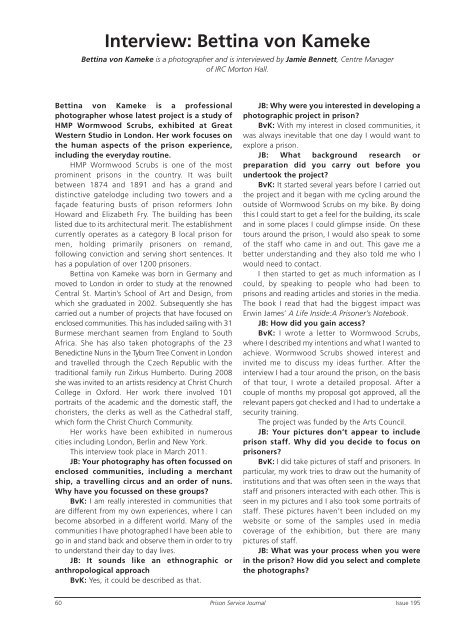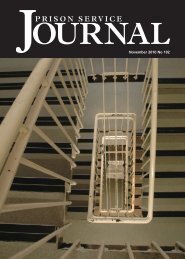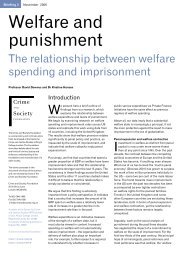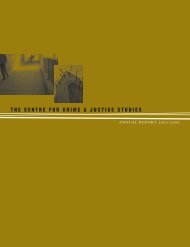Focus on Disability
Focus on Disability
Focus on Disability
You also want an ePaper? Increase the reach of your titles
YUMPU automatically turns print PDFs into web optimized ePapers that Google loves.
Interview: Bettina v<strong>on</strong> Kameke<br />
Bettina v<strong>on</strong> Kameke is a photographer and is interviewed by Jamie Bennett, Centre Manager<br />
of IRC Mort<strong>on</strong> Hall.<br />
Bettina v<strong>on</strong> Kameke is a professi<strong>on</strong>al<br />
photographer whose latest project is a study of<br />
HMP Wormwood Scrubs, exhibited at Great<br />
Western Studio in L<strong>on</strong>d<strong>on</strong>. Her work focuses <strong>on</strong><br />
the human aspects of the pris<strong>on</strong> experience,<br />
including the everyday routine.<br />
HMP Wormwood Scrubs is <strong>on</strong>e of the most<br />
prominent pris<strong>on</strong>s in the country. It was built<br />
between 1874 and 1891 and has a grand and<br />
distinctive gatelodge including two towers and a<br />
façade featuring busts of pris<strong>on</strong> reformers John<br />
Howard and Elizabeth Fry. The building has been<br />
listed due to its architectural merit. The establishment<br />
currently operates as a category B local pris<strong>on</strong> for<br />
men, holding primarily pris<strong>on</strong>ers <strong>on</strong> remand,<br />
following c<strong>on</strong>victi<strong>on</strong> and serving short sentences. It<br />
has a populati<strong>on</strong> of over 1200 pris<strong>on</strong>ers.<br />
Bettina v<strong>on</strong> Kameke was born in Germany and<br />
moved to L<strong>on</strong>d<strong>on</strong> in order to study at the renowned<br />
Central St. Martin’s School of Art and Design, from<br />
which she graduated in 2002. Subsequently she has<br />
carried out a number of projects that have focused <strong>on</strong><br />
enclosed communities. This has included sailing with 31<br />
Burmese merchant seamen from England to South<br />
Africa. She has also taken photographs of the 23<br />
Benedictine Nuns in the Tyburn Tree C<strong>on</strong>vent in L<strong>on</strong>d<strong>on</strong><br />
and travelled through the Czech Republic with the<br />
traditi<strong>on</strong>al family run Zirkus Humberto. During 2008<br />
she was invited to an artists residency at Christ Church<br />
College in Oxford. Her work there involved 101<br />
portraits of the academic and the domestic staff, the<br />
choristers, the clerks as well as the Cathedral staff,<br />
which form the Christ Church Community.<br />
Her works have been exhibited in numerous<br />
cities including L<strong>on</strong>d<strong>on</strong>, Berlin and New York.<br />
This interview took place in March 2011.<br />
JB: Your photography has often focussed <strong>on</strong><br />
enclosed communities, including a merchant<br />
ship, a travelling circus and an order of nuns.<br />
Why have you focussed <strong>on</strong> these groups?<br />
BvK: I am really interested in communities that<br />
are different from my own experiences, where I can<br />
become absorbed in a different world. Many of the<br />
communities I have photographed I have been able to<br />
go in and stand back and observe them in order to try<br />
to understand their day to day lives.<br />
JB: It sounds like an ethnographic or<br />
anthropological approach<br />
BvK: Yes, it could be described as that.<br />
JB: Why were you interested in developing a<br />
photographic project in pris<strong>on</strong>?<br />
BvK: With my interest in closed communities, it<br />
was always inevitable that <strong>on</strong>e day I would want to<br />
explore a pris<strong>on</strong>.<br />
JB: What background research or<br />
preparati<strong>on</strong> did you carry out before you<br />
undertook the project?<br />
BvK: It started several years before I carried out<br />
the project and it began with me cycling around the<br />
outside of Wormwood Scrubs <strong>on</strong> my bike. By doing<br />
this I could start to get a feel for the building, its scale<br />
and in some places I could glimpse inside. On these<br />
tours around the pris<strong>on</strong>, I would also speak to some<br />
of the staff who came in and out. This gave me a<br />
better understanding and they also told me who I<br />
would need to c<strong>on</strong>tact.<br />
I then started to get as much informati<strong>on</strong> as I<br />
could, by speaking to people who had been to<br />
pris<strong>on</strong>s and reading articles and stories in the media.<br />
The book I read that had the biggest impact was<br />
Erwin James’ A Life Inside:A Pris<strong>on</strong>er’s Notebook.<br />
JB: How did you gain access?<br />
BvK: I wrote a letter to Wormwood Scrubs,<br />
where I described my intenti<strong>on</strong>s and what I wanted to<br />
achieve. Wormwood Scrubs showed interest and<br />
invited me to discuss my ideas further. After the<br />
interview I had a tour around the pris<strong>on</strong>, <strong>on</strong> the basis<br />
of that tour, I wrote a detailed proposal. After a<br />
couple of m<strong>on</strong>ths my proposal got approved, all the<br />
relevant papers got checked and I had to undertake a<br />
security training.<br />
The project was funded by the Arts Council.<br />
JB: Your pictures d<strong>on</strong>’t appear to include<br />
pris<strong>on</strong> staff. Why did you decide to focus <strong>on</strong><br />
pris<strong>on</strong>ers?<br />
BvK: I did take pictures of staff and pris<strong>on</strong>ers. In<br />
particular, my work tries to draw out the humanity of<br />
instituti<strong>on</strong>s and that was often seen in the ways that<br />
staff and pris<strong>on</strong>ers interacted with each other. This is<br />
seen in my pictures and I also took some portraits of<br />
staff. These pictures haven’t been included <strong>on</strong> my<br />
website or some of the samples used in media<br />
coverage of the exhibiti<strong>on</strong>, but there are many<br />
pictures of staff.<br />
JB: What was your process when you were<br />
in the pris<strong>on</strong>? How did you select and complete<br />
the photographs?<br />
60 Pris<strong>on</strong> Service Journal<br />
Issue 195











